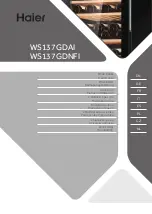
27
Light accelerates the ageing of wine. In our solid door cellars, your wines are naturally protected, on
condition, of course, that the door is not opened too often. This glass-door model has been specially treated
and filters out harmful ultraviolet rays, thus ensuring your wines are perfectly shielded.
Defrosting
Your appliance is equipped with an automatic defrost cycle. When a cooling cycle finishes, t
he appliance’s
refrigerated surfaces are defrosted automatically. The defrost water is channeled into a condensates
evaporation tray which is located in the back of the appliance near the compressor. The heat produced by the
compressor then evaporates the condensates collected in the tray.
The winter function
The winter function is a frost protection system which enables the cellar to operate in an environment where
the temperature is between 5 and 38°C. A sensor located outside the appliance triggers a low power
electrical element when the ambient temperature in the room falls to around 8°C in case. This is a low power
element to avoid sudden rises in the temperature of the wine and so avoid thermal shocks that are damaging
to the preservation of the wine.
The kit is intended to raise the cellar’s internal temperature even before there
is a thermal exchange with the bottles.
Shelves
▪
To prevent damage to the door seal, ensure that the door is fully open before pulling out the shelves to
add or remove bottles.
▪
For easier access to the contents of the shelves, slide the shelf out approximately one third of the way.
The shelves are, however, fitted with a stop to prevent the bottles falling out.
7. LOADING
The maximum recommended loading quantities for bottles are given as guidelines and are indicative only;
they provide a quick estimate of the size of the appliance (similar to the capacity of a refrigerator expressed in
liters).
They correspond to tests conducted with
a standard bottle: the standard “75 cl light Bordeaux” bottle
-standards apply the geographical origin of each bottle shape (Bordeaux, Burgundy, Provence, etc.) and a
type (traditional, heavy, light, flute, etc.), each with its own diameter and height.
These caves present bottles of wine, thanks to the highlighting of the labels of each wine. You will find below
the plan of loading of your bottles on a clay, knowing that it is possible to put up to 9 bottles on a shelf.
Back of the shelf
















































